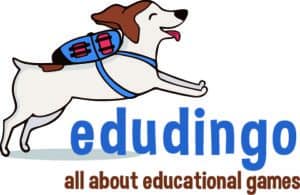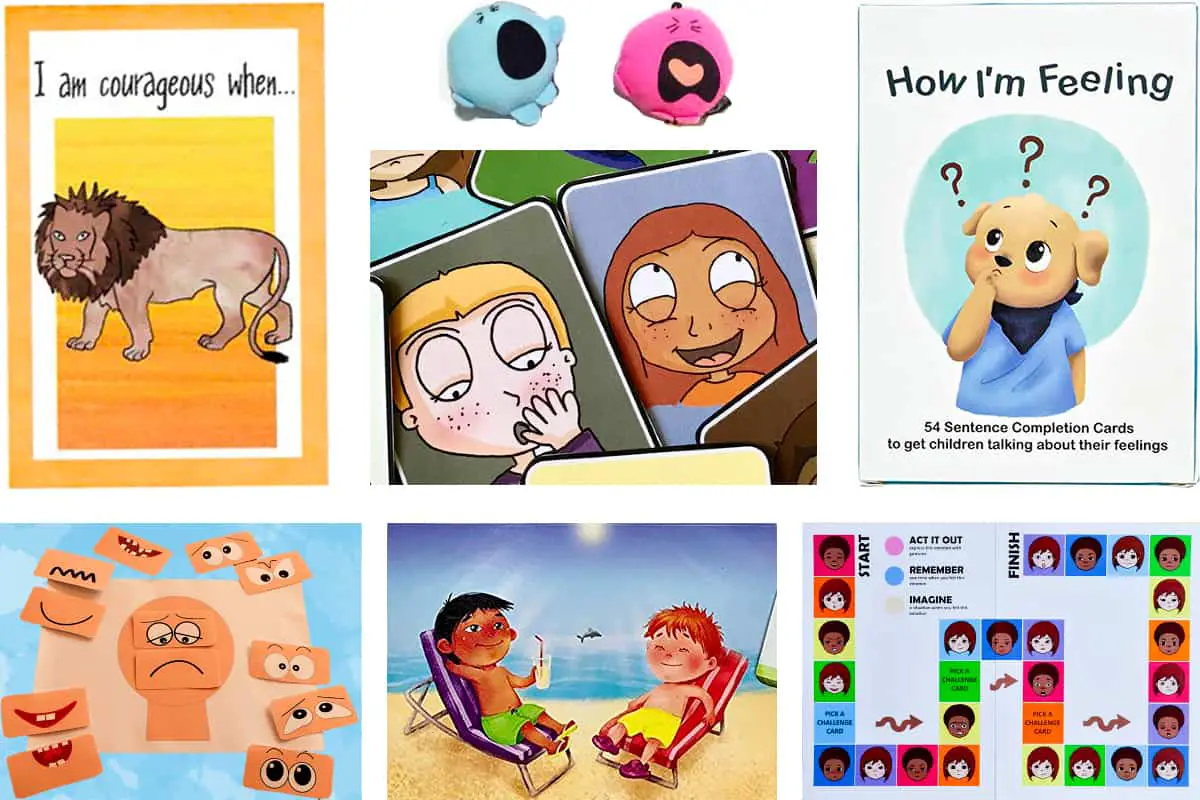This post contains affiliate links.
Identifying and understanding emotions is the first step toward developing empathy. I am currently working on a future empathy game. So I thought it was a great opportunity to give you an overview of the best games about emotions for preschoolers.
There are over 40 board and card games about emotions for preschoolers and kindergarten:
- Emotion matching card games, bingos, and flashcards, which are great to teach the emotions themselves,
- Sentence completion card games, which help children to express themselves about their emotions
- Games that develop empathy and coping skills (they will be covered in another post).
Here are the games that I found to best contribute to increasing emotion-related competencies, sorted according to preschool and kindergarten competencies they address (using Massachusets’ SEL1** standard):
Emotion Board & Card Games Sorted By Standard Competencies
| SEL | Preschool | Kindergarten |
| 1.1 | Recognize & label basic emotions, associate with words, facial expressions, gestures Feelings Feel. card games Feel/emo activit  . . Emotions go fish Emo. photo bingo Ups and downs Feelings & emo. Feel. & dealings Mini kimochis Moogy Make a face Magn. flashcards Feel/em flashc. | Recognize complex emotions, associate with facial expressions, body language, behaviors Feelings Feel. card games Feel/emo activities  Emotions go fish Emo. photo bingo How I am feeling Feelings & emo. Feel. & dealings Mini kimochis Magn. flashcards |
| 1.2 | Begin to develop a rich vocabulary related to emotions/feelings Feel. card games Feel. and dealings Emotion-oes | Use richer vocabulary related to the nuances of emotions |
| 1.3* | Express emotions (gestures, actions, drawing, language) | Express and share own feelings in a variety of ways Emotions |
| 1.4 | Begin to understand the connection between feelings and behaviors How I’m feeling Feel. thoughts emo. Feel. & emotions | Describe reasons for own feelings and situations that cause them. How I’m feeling Feel. thoughts emo. |
*With Support
**All 50 American states have SEL (Social and Emotional Learning) standards for schools, but no common state standard exists (contrary to Maths and ELA). So I decided to use the Massachusetts preschool SEL standard, a well-regarded one. The relevant sections of this standard are: - SEL1: Ability to recognize, identify, and express his/her emotions - SEL4: Impulse control and stress management - SEL5: Empathy - APL3: Focus, attention, and persistence
In this post, I focus on SEL1 which is the base, and I leave SEL4, SEL5, and APL3 for future posts on empathy building and coping skills.
Emotion Board and Card Games For Each Situation
This second table shows the emotion-related games I recommend according to the typical situation the game is played in:
| Situation | Game Type | Best Games |
| Child plays with adult: Home Sp. educ. Therapist | 2+ player Adult lets child win | Feelings Feel. card gam. How I’m feel. F. thought em. Emo. go fish Ups & downs How I am feel. Emotions Feel. & emo. Feel. & deal. Moogy Make a face |
| Different ages Home Game library | Non-comp.* Adult help possible | Feelings Emo. go fish Emotion-oes |
| Classroom Group play | Autonomous Not noisy 3/4 players Non-comp.* | Feel. card games |
| School centers | Gamified activities Autonomous 1/2 players | Feel. card games Feel/emo. act  . . Mini kimochis Make a face |
| Teacher plays with class | Whole class Large cards | Emo photo bingo Mini kimochis Magn. flashcards Feel. & emo. flash. |
*Non-competitive (competence wise)
Here I include regular games and printable games (free or not). This information is included in brackets.
5 Sentence Completion Card Games To Speak About Emotions
These games enable children to speak about their emotions.
Each card has the beginning of a sentence like for instance “I get frustrated when…”. Players draw cards and complete their sentences. You would think that such a basic principle would not work… but it does. The cards (with well-chosen illustrations and sentences) actually encourage players to complete the sentences and say things they would otherwise never say.
So I highly recommend trying this kind of game which enables parents, therapists, and teachers to better understand how their children, patients or students feel and react. My two favorites here are:
How I’m Feeling (Impresa)

(Impresa): The illustrations of How I’m Feeling are really cute and non-threatening. The choice of questions is wide and includes both easy sentences (when it’s warm out I feel…) as well as more difficult ones (I get annoyed when…). Plus there are 52 cards (for $15) so there are many questions to answer.
Feelings, Thoughts & Emotions (Printable – WholeHearted School Counseling)
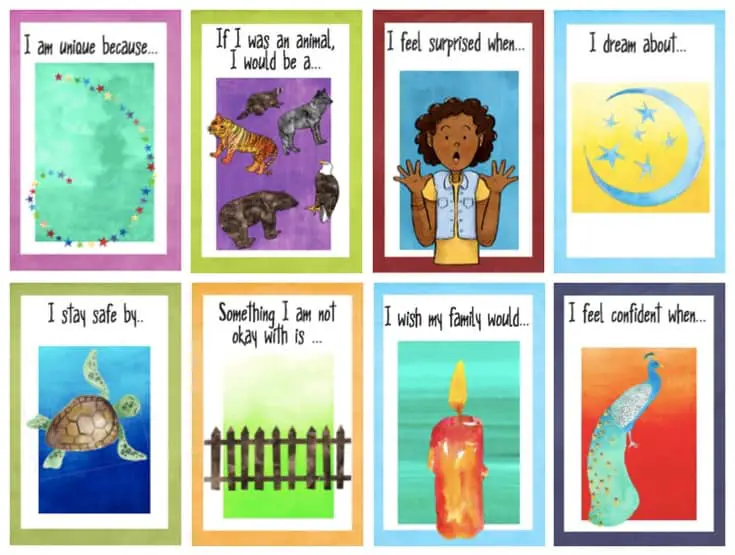
The “Feelings, Thoughts and Emotions” printable game is different in the way it is illustrated: instead of using characters, the 52 cards feature illustrations that evoke the corresponding feeling or thought in a beautiful way. I find this to be an interesting way to illustrate this type of game that will certainly appeal to many people, so make sure to check this game out.
The following games are possible choices as well:
- Thoughts and feelings
 (Bright Spots Games): 35 cards (for $$). I personally prefer “How I’m feeling” because the “cost per card” is half and the illustrations are cuter (although this is a question of personal taste). But “Thoughts and feelings” is a good game as well and I recommend it of course. I also recommend Thoughts and Feelings 2
(Bright Spots Games): 35 cards (for $$). I personally prefer “How I’m feeling” because the “cost per card” is half and the illustrations are cuter (although this is a question of personal taste). But “Thoughts and feelings” is a good game as well and I recommend it of course. I also recommend Thoughts and Feelings 2 which can be used together.
which can be used together. - Finish It!
 (Printable – Empower Life Skills) uses the same principle. It comprises 48 cards. I recommend this game as the sentences are well thought out and of course it is cheaper than a regular game.
(Printable – Empower Life Skills) uses the same principle. It comprises 48 cards. I recommend this game as the sentences are well thought out and of course it is cheaper than a regular game. - Mad Skillz
 (Thought Spot): the cards in this sentence completion game are not separable, they are included in a book with ring binders. I do not like it very much because this is way less user-friendly and flexible than regular card decks.
(Thought Spot): the cards in this sentence completion game are not separable, they are included in a book with ring binders. I do not like it very much because this is way less user-friendly and flexible than regular card decks.
9 Emotion Matching Card Games for Kindergarten & Preschoolers
These games enable you to play any rule based on matching two cards together, like “Go Fish”, “Memory” or “Old Maid” (if there no special card in the game, you can transform one of the emotions into a special card). As these matching rules are extremely simple, you can play them with children from 4-Year-old and up.
Feelings (MK Games)

“Feelings ” is a “memory” game with faces showing emotions. Faces are actual pictures rather than drawings or icons. I like it to recognize emotions on real faces rather than on made-up illustrations that might not reflect the reality and nuance of the emotion (all depending on the skill of the illustrator). But the game is expensive for only 20 emotions depicted. The cards are from thick cardboard though so they are very durable and suitable for classrooms.
” is a “memory” game with faces showing emotions. Faces are actual pictures rather than drawings or icons. I like it to recognize emotions on real faces rather than on made-up illustrations that might not reflect the reality and nuance of the emotion (all depending on the skill of the illustrator). But the game is expensive for only 20 emotions depicted. The cards are from thick cardboard though so they are very durable and suitable for classrooms.
Feeling Card Games (WholeHearted School Counseling)
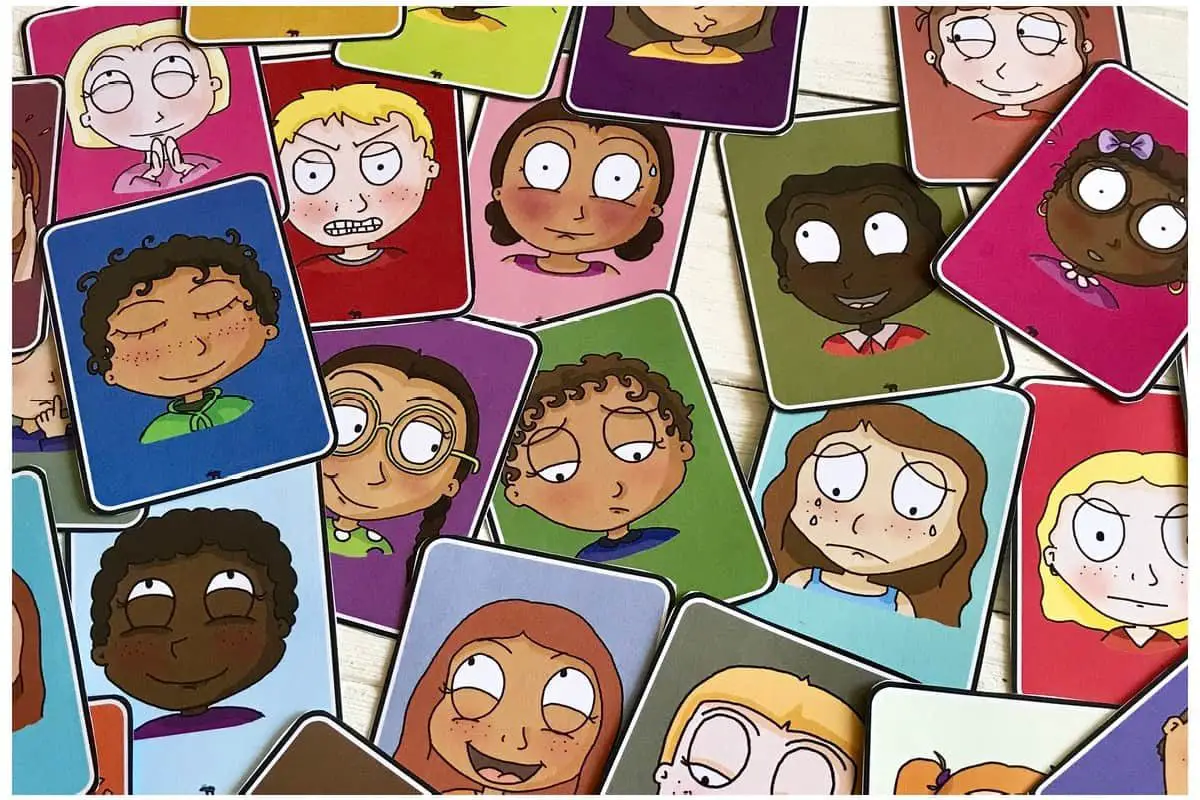
“Feeling Card Games ” is a Printable. The nice thing with this game is that there are three different sets of cards:
” is a Printable. The nice thing with this game is that there are three different sets of cards:
- Feeling faces only
- Feeling faces with feeling written
- Feeling faces with feeling & question.
You can print whichever works best for your objective. The cards are cute and are available with color background, white background or completely black & white. There are also 20 “feeling question cards” & 48 “how might you feel” situation cards, which is very good.
The only drawback I see is that I would have liked the cards to be a little smaller (for the little hands of preschoolers). But you can tweak this when you are printing them.
Feelings and Emotions Activities and Centers (KidSparks):
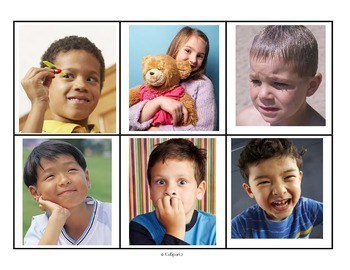
Feelings and Emotions Activities and Centers is also a very good Printable because it has well-thought content:
is also a very good Printable because it has well-thought content:
- Real pictures of children depicting the various emotions (working with emotions from real pictures trumps using illustrations in my opinion) that you can use for matching games
- Facial features to cut and paste on blank faces to create faces with different emotions
- 32 situation cards.
Emotions Go Fish (Autism Inspiration) – FREE Printable
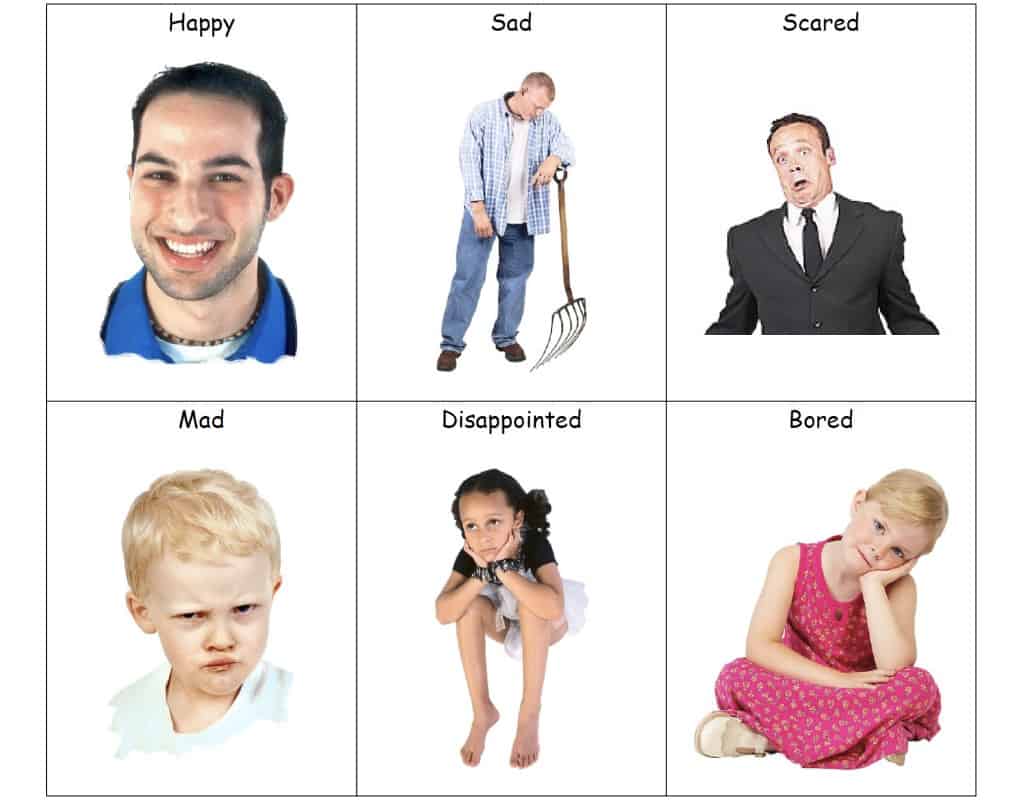
“Emotions Go Fish ” is a good matching game that contains 24 different actual pictures of Characters with emotions. It is well made for a free resource so I really recommend it.
” is a good matching game that contains 24 different actual pictures of Characters with emotions. It is well made for a free resource so I really recommend it.
The following games are possible choices as well :
- Feelings Playing cards
 (Jim Borgman): This game comes with 15 different rules for different purposes: identifying emotions, creative sentence building or storytelling. These 15 rules can be played with all the other card games in this section in fact.
(Jim Borgman): This game comes with 15 different rules for different purposes: identifying emotions, creative sentence building or storytelling. These 15 rules can be played with all the other card games in this section in fact.
Coming up with 15 rules is a good idea, but I find the illustrations on the cards are not very understandable (emotions are exaggerated, faces not appealing). The cards are also too big for small children. Overall, I do not recommend this game for children under 7-year-old. - Talking About Feelings
 (The Berenstein Bears): Although the bears are sweet, there are only 13 emotions in this game and the game is in my opinion way too expensive for its content.
(The Berenstein Bears): Although the bears are sweet, there are only 13 emotions in this game and the game is in my opinion way too expensive for its content. - Emotion Recognition Pack
 (Printable – Life Over C’s): This pack is really comprehensive (not only matching cards but also bingo, 2 piece puzzles). But I do not like the fact that characters are entire bodies (not the face only) making the emotions hard to read.
(Printable – Life Over C’s): This pack is really comprehensive (not only matching cards but also bingo, 2 piece puzzles). But I do not like the fact that characters are entire bodies (not the face only) making the emotions hard to read. - The Game of Mixed Emotions
 (Teresa Claire): 24 emotions are classified in 4 color-coded categories (mixing high/low energy & comfortable/uncomfortable). The two matching cards for each emotion are a boy and a girl. There are 4 emotion matching rules (similar to Uno, Go Fish, Memory & Bingo), and a rule to start conversations (you ask the children when they have experienced the emotion on the card). The design is nice and colorful, but the game is rather expensive for 48 cards.
(Teresa Claire): 24 emotions are classified in 4 color-coded categories (mixing high/low energy & comfortable/uncomfortable). The two matching cards for each emotion are a boy and a girl. There are 4 emotion matching rules (similar to Uno, Go Fish, Memory & Bingo), and a rule to start conversations (you ask the children when they have experienced the emotion on the card). The design is nice and colorful, but the game is rather expensive for 48 cards. - Feelings & Emotions Cards
 (FREE Printable – Childhood 101): This one is a basic set of illustrated characters with 12 emotions. A bit too basic to be that useful – but it is free so why not try it out?
(FREE Printable – Childhood 101): This one is a basic set of illustrated characters with 12 emotions. A bit too basic to be that useful – but it is free so why not try it out?
3 Bingo Games About Emotions for Kindergarten & Preschoolers
The principle of these games is that each player has a set of pictures depicting characters with emotions (photos or illustrations). The game master draws emotions and each player will identify if he/she has it. As only luck determines the winner this type of game is very good for schools.
They are good at recognizing facial emotions and labeling them (as the teacher can just say which emotion it is without showing the corresponding card). And you can start to use them with Pre-K children.
Emotions Bingo With Photos (KidSparkz)
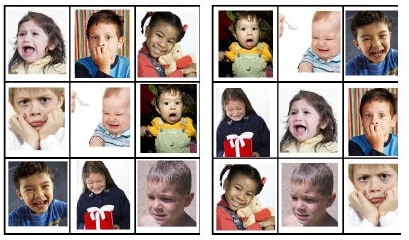
“Emotions Bingo with Photos ” (Printable) is a good example of such bingos. I like the realism of the pictures (once again this is my preference compared with using illustrations or emojis).
” (Printable) is a good example of such bingos. I like the realism of the pictures (once again this is my preference compared with using illustrations or emojis).
These other bingo games are also available :
- Faces and Feelings Lotto
 (Key Education): I do not recommend it for preschoolers and kindergarten as the CD is too fast and depicted emotions are often ambiguous. It can be used differently though (without the CD) for better results.
(Key Education): I do not recommend it for preschoolers and kindergarten as the CD is too fast and depicted emotions are often ambiguous. It can be used differently though (without the CD) for better results.
- Emotions and Feelings Bingo
 (Printable – Drag Drop Learning Games): This resource is rather comprehensive (30 bingo boards, 24 calling cards), but I am really not fond of using “emoticons” for depicting emotions. I find that they are too far from the real corresponding emotion… Though, I have to admit that children love emojis, so you might give it a try.
(Printable – Drag Drop Learning Games): This resource is rather comprehensive (30 bingo boards, 24 calling cards), but I am really not fond of using “emoticons” for depicting emotions. I find that they are too far from the real corresponding emotion… Though, I have to admit that children love emojis, so you might give it a try.
6 Board Games About Emotions for Kindergarten & Preschoolers
4 to 6 Year-olds can start to play board games. But they have a short attention span, and they are very active. So only board games with extremely simple rules and a very short game duration will actually work for them.
Ups And Downs (School Counseling is Magical)
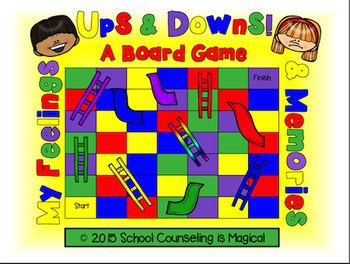
“Ups and Downs ” is a Printable game using the same principle as “Chutes and ladders”, with questions about emotions written on cards. The questions are well thought out and span many aspects of how emotions occur, manifest themselves and what to do about them. Pedagogically the game is great, although I am not a fan of the design I would really recommend “Ups and Downs“.
” is a Printable game using the same principle as “Chutes and ladders”, with questions about emotions written on cards. The questions are well thought out and span many aspects of how emotions occur, manifest themselves and what to do about them. Pedagogically the game is great, although I am not a fan of the design I would really recommend “Ups and Downs“.
How I Am Feeling (FREE Printable – Mosswood Connections)
“How Am I Feeling ” is a “basic” (no illustration) board game with an original principle and is quite fun. The player whose turn it is has to say a sentence while acting out an unrelated emotion that the other players have to guess from 6 possibilities.
” is a “basic” (no illustration) board game with an original principle and is quite fun. The player whose turn it is has to say a sentence while acting out an unrelated emotion that the other players have to guess from 6 possibilities.
This game was originally created to make autistic children more aware of other people’s facial expressions, but as the game is fun for anyone, I recommend it beyond this as a family game. As the emotions are written down the game takes more time playing with children who do not yet read (you will have to read for them the 6 emotions to choose from). So it is possible to play with a 5-Year-old, even if it is faster with 7-Year-olds and older.
Tip: with 5 Year-olds, you can have them choose between 3 emotions instead of 6. It will be easier for them to remember the one they have to play or they have to guess.
Emotions (Liska Myers)

“Emotions ” is a printable board game. It is both simple and useful, so you can give it a try from 5 Year Old. Players progress on a track and have three possible actions when they land on a new game’s square:
” is a printable board game. It is both simple and useful, so you can give it a try from 5 Year Old. Players progress on a track and have three possible actions when they land on a new game’s square:
- Act on an emotion
- Tell a time when they felt this emotion
- Tell a situation that could cause this emotion.
There are also “challenge cards” where the player might be asked for example what do do when experiencing a specific emotion.
Feelings and Emotions (Printable – Communication Blessings)
“Feelings and Emotions ” is a printable board game with 2 emotion board games as well as emotion cards (with emotions that you have to identify or questions you have to answer). The rules are very basic, but the material is really relevant and varied, which makes it a really nice resource.
” is a printable board game with 2 emotion board games as well as emotion cards (with emotions that you have to identify or questions you have to answer). The rules are very basic, but the material is really relevant and varied, which makes it a really nice resource.
You also have :
- Inside Out Emotions Board Game
 (FREE Printable – Printable Crush): I would not recommend because I find the cards to be unrealistic (you do not really recognize the emotions). But if your children are fond of “inside out” characters it might be the right game for you.
(FREE Printable – Printable Crush): I would not recommend because I find the cards to be unrealistic (you do not really recognize the emotions). But if your children are fond of “inside out” characters it might be the right game for you. - Monster Feelings
 (FREE printable – Pocket of Preschool): The idea of having monsters and icons with the same expressions is good. I do not find the expressions very realistic, but you can try this game.
(FREE printable – Pocket of Preschool): The idea of having monsters and icons with the same expressions is good. I do not find the expressions very realistic, but you can try this game.
8 Emotion Games Using Other Game Principles for Kindergarten & Preschoolers
Feelings And Dealings (Game On Family)
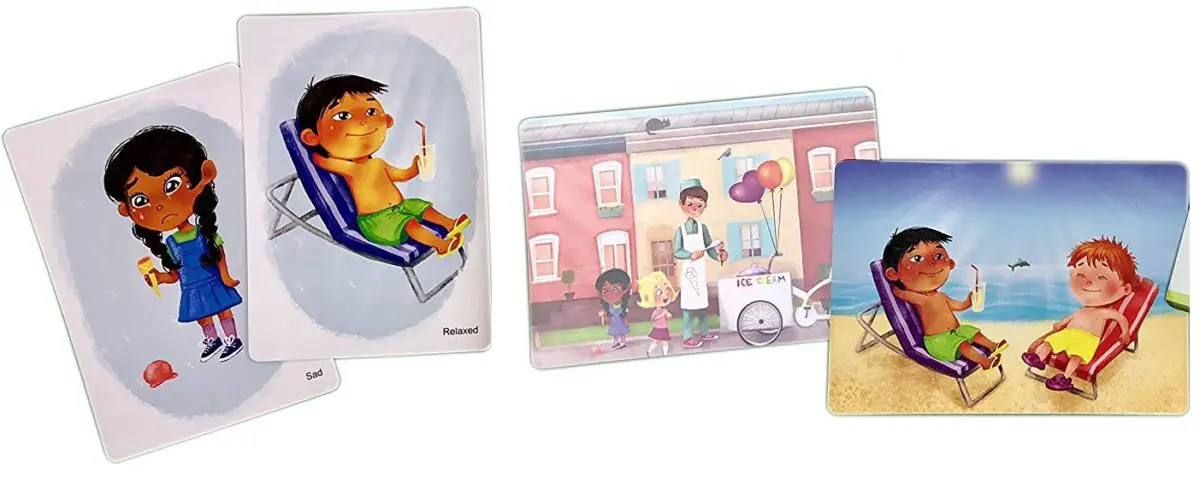
“Feelings and Dealings ” is really interesting because there are faces and scenes (24 emotion cards, 24 social scene cards) that illustrate the same feelings. This really enriches the principle of usual “emotion faces” games as it encourages discussion and comments about the situation. As a result, there are 8 different rules which enable to adapt the game to many situations.
” is really interesting because there are faces and scenes (24 emotion cards, 24 social scene cards) that illustrate the same feelings. This really enriches the principle of usual “emotion faces” games as it encourages discussion and comments about the situation. As a result, there are 8 different rules which enable to adapt the game to many situations.
Mini Kimochis
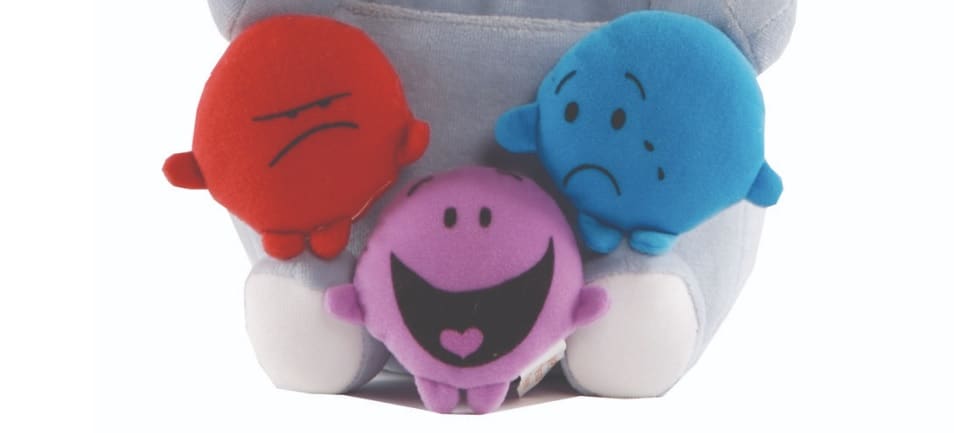
The Mini Kimochis are 33 really cute plush toys. Each of them expresses a different emotion (written on their back as well). A 64-pages guide explains various ways to use them. they can be used by professionals (schools, educators), but might be too expensive for most parents. They are perfect for interaction with preschool or kindergarten children, as they love plush toys. Highly Recommended as far as I am concerned!
are 33 really cute plush toys. Each of them expresses a different emotion (written on their back as well). A 64-pages guide explains various ways to use them. they can be used by professionals (schools, educators), but might be too expensive for most parents. They are perfect for interaction with preschool or kindergarten children, as they love plush toys. Highly Recommended as far as I am concerned!
Note: I love the name of the game as well as it is named after the Japanese word “kimochi” (気持ち) which means “feeling”.
Emotion-Oes (Key Education)
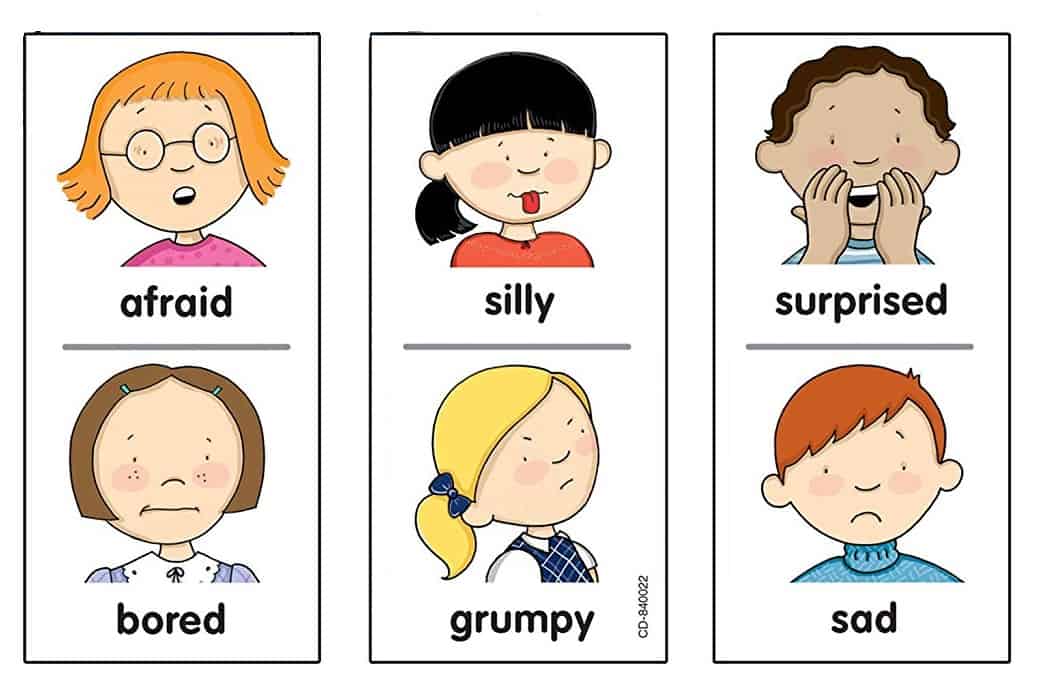
Emotion-Oes is a domino game with 56 dominoes. Each domino features two faces with two different emotions and the name of each emotion. Each emotion is repeated 4 times, so overall you have 28 different emotions, which is comprehensive. Dominoes are made of thick cardboard and quite big so as to see the faces clearly.
is a domino game with 56 dominoes. Each domino features two faces with two different emotions and the name of each emotion. Each emotion is repeated 4 times, so overall you have 28 different emotions, which is comprehensive. Dominoes are made of thick cardboard and quite big so as to see the faces clearly.
The only problem is that the emotions depicted are ambiguous. Here, for instance, I do not really understand “bored” when I see it without the word written. You might find the girl has a puzzled look, or just does not want to show her emotion, or is impassive, which is an interesting face expression as well. So I recommend using this game for building the vocabulary around emotions, not to learn to read facial expressions.
Moogy (Miniland)
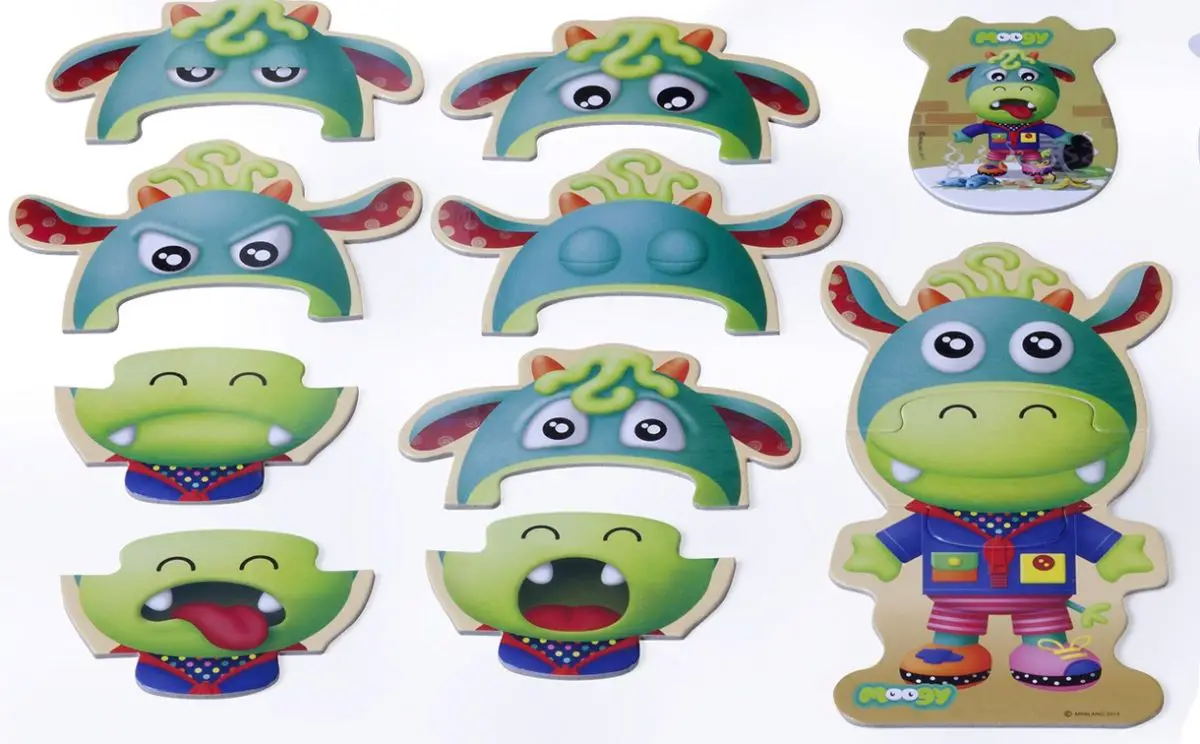
Moogy (Miniland, 3+) includes 11 puzzle pieces (you build a face by assembling two pieces) and 8 emotion cards of “Moogy”, a donkey that experiences these emotions. The game is really good for putting names on the basic emotions and to understand how a given emotion translates on one’s face (recognition of emotions). It is suited especially for families (cheap and simple) but can also be used in other settings. The “Moogy” character is funny and engaging, and the pieces of thick cardboard are really durable.
(Miniland, 3+) includes 11 puzzle pieces (you build a face by assembling two pieces) and 8 emotion cards of “Moogy”, a donkey that experiences these emotions. The game is really good for putting names on the basic emotions and to understand how a given emotion translates on one’s face (recognition of emotions). It is suited especially for families (cheap and simple) but can also be used in other settings. The “Moogy” character is funny and engaging, and the pieces of thick cardboard are really durable.
Make A Face (Elsa Support)

Make a face is a really original resource. The emotions you can build by combining eyes and mouth as proposed are surprisingly expressive, even though the pieces are really basic (blank head 12 mouths, 12 sets of eyes, plus vocabulary cards – with 3 different skin tones).
is a really original resource. The emotions you can build by combining eyes and mouth as proposed are surprisingly expressive, even though the pieces are really basic (blank head 12 mouths, 12 sets of eyes, plus vocabulary cards – with 3 different skin tones).
You can also use the following game which I do not recommend though:
- Friends and Neighbors
 (Peaceable Kingdom): the game seems cool at first because it is a cooperative game, and you are trying to help characters on the board. The problem in this game is that the underlying mechanism (drawing tokens that depict objects that you match with other tokens) does not at all aid in understanding the emotions of the characters on the board. I would not recommend this game, which does not reach its purpose.
(Peaceable Kingdom): the game seems cool at first because it is a cooperative game, and you are trying to help characters on the board. The problem in this game is that the underlying mechanism (drawing tokens that depict objects that you match with other tokens) does not at all aid in understanding the emotions of the characters on the board. I would not recommend this game, which does not reach its purpose. - Feelings/Emotions Rainbow Wooden Peg Dolls
 (My Felt Story): These little wooden dolls are very basic (only 6 emotions) but can appeal to 3 or 4-year-old children, for instance, to make mini-stories with characters that have one specific emotion.
(My Felt Story): These little wooden dolls are very basic (only 6 emotions) but can appeal to 3 or 4-year-old children, for instance, to make mini-stories with characters that have one specific emotion. - Emotiblocks
 (Miniland): They are not as interesting as Moogy (also by Miniland) in my opinion as you do not build the expression of the emotion with these “lego-looking” characters.
(Miniland): They are not as interesting as Moogy (also by Miniland) in my opinion as you do not build the expression of the emotion with these “lego-looking” characters.
5 Emotion Flashcards for Kindergarten & Preschoolers
OK, I was tired today and I did not list many emotion flashcards (there are many). Here is a sample though!
Magnetic Flashcards – Basic Emotions (Attractivia)
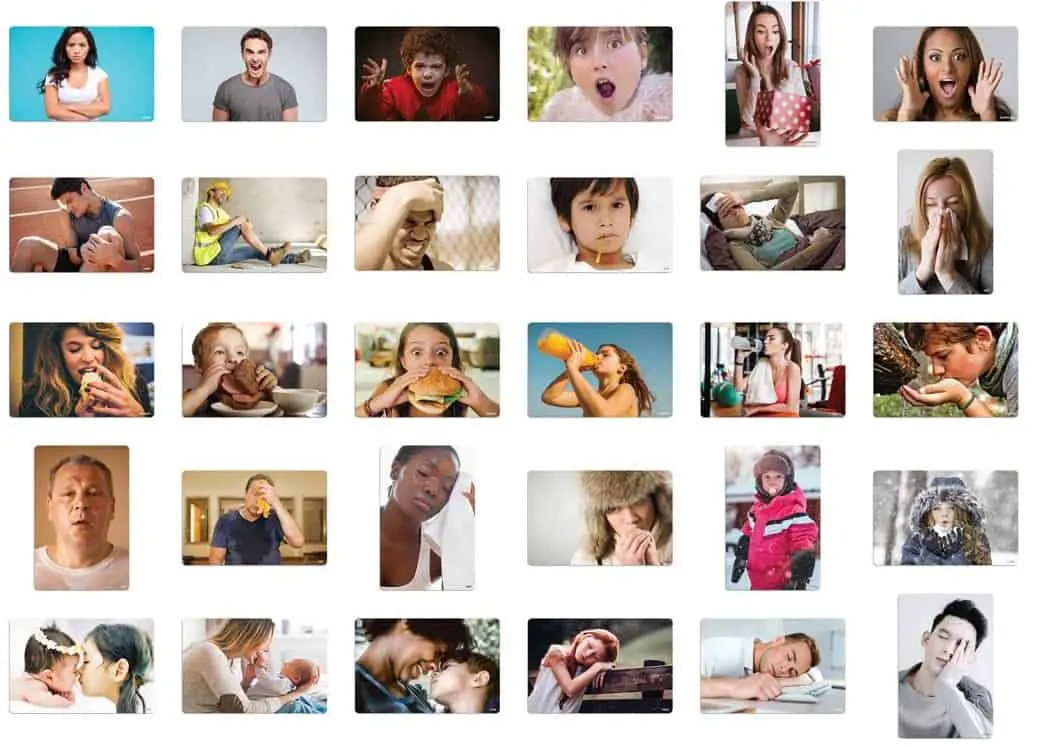
These flashcards are really great and I highly recommend them. Each emotion is expressed by 4 different people, with high-quality pictures that are also natural. the cards are magnetic. The feelings covered are Surprise, Happiness, Sadness, Anger, Being Hurt, Sickness, Hunger, Thirst, Heat, Cold, Tiredness, and Love.
are really great and I highly recommend them. Each emotion is expressed by 4 different people, with high-quality pictures that are also natural. the cards are magnetic. The feelings covered are Surprise, Happiness, Sadness, Anger, Being Hurt, Sickness, Hunger, Thirst, Heat, Cold, Tiredness, and Love.
Feelings and Emotions Flash Cards (Picture My Picture)
These are large flashcards , of very high photo quality and sturdy. And it is excellent to have the same expression played by different people. The game is almost perfect… But some of these emotions are not so recognizable. For example, the “Happy” faces feel like people who smile for a picture. And the “angry” ones are shouting like mad. I recommend the game anyway, but if you want something really feeling natural, go take “Magnetic Flashcards” rather than this game.
, of very high photo quality and sturdy. And it is excellent to have the same expression played by different people. The game is almost perfect… But some of these emotions are not so recognizable. For example, the “Happy” faces feel like people who smile for a picture. And the “angry” ones are shouting like mad. I recommend the game anyway, but if you want something really feeling natural, go take “Magnetic Flashcards” rather than this game.
You also have alternatives with emojis, monsters or illustrations of people:
- Emotion Flashcards
 (mockeri): I am not very fond of emojis for expressing emotions (I find them too basic and symbolic), but if you like them you can look at these emoji flashcards.
(mockeri): I am not very fond of emojis for expressing emotions (I find them too basic and symbolic), but if you like them you can look at these emoji flashcards. - Gifted Learning Flash Cards (TestingMom): To me, these monsters have emotions that are too far from regular emotions, so I am not really recommending
- 14 Emotions Flashcards (Santsun): The emotions are quite recognizable. This is a good thing, especially for characters that are illustrated.
Games That Develop Empathy & Coping Skills
Learning about emotions is an initial ESL step. Next comes to:
- Cope with and control emotions, especially Anger, Sadness
- Develop Empathy
There are many games on this. I will develop them in a further post. If you cannot wait here is an initial “raw” list:
Coping Skills And Self-Control Games
- Stop, Relax and Think
 (childswork)
(childswork) - No Waries
 (Storm)
(Storm) - Playing CBT
 (Shelly Zantkeren)
(Shelly Zantkeren) - My Feelings (Sensational Learners)

- Mad Dragon
 (TherapyGameHQ)
(TherapyGameHQ) - The Coping Skills Game

- Don’t Go Bananas (Da Vinci’s Room)
- Conflict Resolution card game
 (Carol Miller -The Middle School Counselor)
(Carol Miller -The Middle School Counselor)
Empathy Games
- Empathy Game
 (Pathway to Success)
(Pathway to Success) - The Empathy Game
 (Lawrence Shapiro)
(Lawrence Shapiro) - Snoot Toots
 (Youthlight)
(Youthlight) - The No-Fault Zone Game
 (Sura Hart, Victoria Kindle Hodson ), an NVC game
(Sura Hart, Victoria Kindle Hodson ), an NVC game - Grok
 (Christine King, Jean Morrison), an NVC game
(Christine King, Jean Morrison), an NVC game - Social Skills
 (SmartKids)
(SmartKids) - Empathy Card game
 (WholeHearted School Counseling)
(WholeHearted School Counseling) - The Social & Emotional Competence Game
 (Gary Yorke)
(Gary Yorke) - Feelings Detective
 (Franklin Learning Systems)
(Franklin Learning Systems) - Feelings and Emotions
 (Printable – Communication Blessings)
(Printable – Communication Blessings) - The Empathy Game
 (Bispublishers)
(Bispublishers) - The Empathy Toy
 (Twenty One Toys)
(Twenty One Toys) - Totem
 (Totem Team)
(Totem Team) - Caring Cats
 (Chalk and Chuckles)
(Chalk and Chuckles) - U Know
 (Therapy U)
(Therapy U) - 52 Essential Conversations
 (Mind Brain Parenting)
(Mind Brain Parenting) - Feeling Card Games
 (WholeHearted School Counseling)
(WholeHearted School Counseling) - Emotions Detective
 (Miniland)
(Miniland) - Friends & Neighbors
 (Peaceable Kingdom Press)
(Peaceable Kingdom Press)
Edudingo.com is a participant in the Amazon Services LLC Associates Program, an affiliate advertising program designed to provide a means for sites to earn advertising fees by advertising and linking to Amazon.com. We also participate in other affiliate programs which compensate us for referring traffic.
